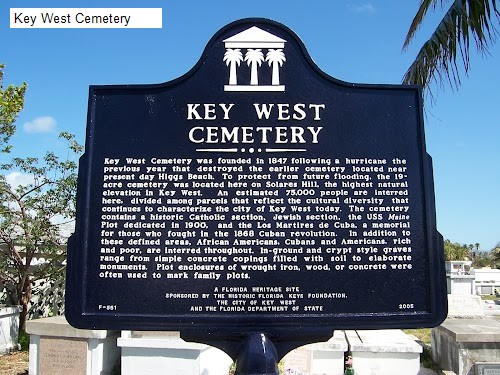5 /5 Jeremy Edmunds: In the heart of Key Wests Old Town, a 19-acre plot of land holds more stories than the island itself can tell. The Historic Key West Cemetery, established in 1847 after a hurricane disinterred the previous burial ground, stands as both historical archive and cultural mosaic of this southernmost American outpost.
Under the relentless Florida sun, some 100,000 souls rest here, more than three times the islands current population, in a dense arrangement of above-ground tombs necessitated by the islands stubborn limestone bedrock and high water table. Walking along the cemeterys named streets and avenues (an unconventional city planning approach for the dead), visitors discover a remarkable cross-section of Key Wests layered history.
The cemeterys architecture tells its own tale of cultural confluence. Gothic arches, classical columns, ornate Victorian monuments, and simple concrete slabs coexist in visual conversation. The elegant white "PAPY" mausoleum with its decorative ironwork stands in stark contrast to weathered family plots with crumbling markers. Many graves bear the unmistakable patina of the harsh marine environment, salt-etched, hurricane-battered, and in alarming states of disrepair. Broken columns, toppled stones, and fading inscriptions arent merely aesthetic concerns but represent the potential erasure of irreplaceable historical records.
What distinguishes this burial ground is its representation of Key Wests unique position as cultural crossroads. The "Los Martires de Cuba" section honors those who fought for Cuban independence, with Cuban and American flags flying side by side. This multicultural heritage extends throughout, with sections dedicated to various religious denominations and cultural groups that have shaped the islands identity.
The cemeterys famous epitaphs reveal the characteristic wit of conch republic denizens. While Pearl Roberts gravestone declaring "I told you I was sick" remains the most celebrated, Gloria Russells "Im just resting my eyes" follows closely in the tradition of Keys humor that persists beyond the grave.
Notable residents include victims of the USS Maine disaster, Confederate sailors, and "Sloppy" Joe Russell (1889-1941), Ernest Hemingways drinking companion and owner of the famous bar. Yet for every well-maintained memorial to a famous resident, dozens of historically significant markers slowly surrender to time and elements.
The cemeterys current condition presents a preservation paradox. While some family plots receive meticulous care, many others, whose descendants have either departed or died themselves, fall into neglect. Without a substantial endowment or perpetual care fund, this open-air museum of Key West history faces an uncertain future. The citys limited resources cannot address the extensive restoration needs, from stabilizing foundations to repairing broken markers and reinforcing weathered inscriptions.
Whats needed is a community-wide commitment to preserve this irreplaceable historical resource. A dedicated preservation fund with contributions from tourism revenue, private donors, and preservation grants could establish the sustainable care these grounds deserve. Without such intervention, each tropical storm and hurricane season threatens to further diminish this unique chronicle of island life.
For visitors, the cemetery offers more than macabre tourism, it presents a compressed historical record of this unique American outpost. Under swaying palms and against brilliant blue skies, Key West Cemetery embodies the island itself: weathered yet resilient, serious yet irreverent, multicultural yet distinctly individual, a place where history and humor rest eternally side by side, awaiting the care that will ensure they remain legible for generations to come.


